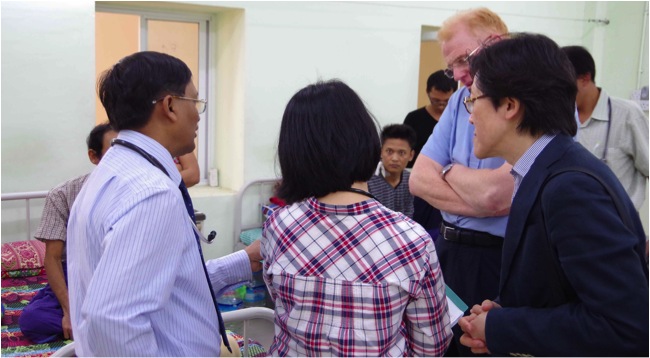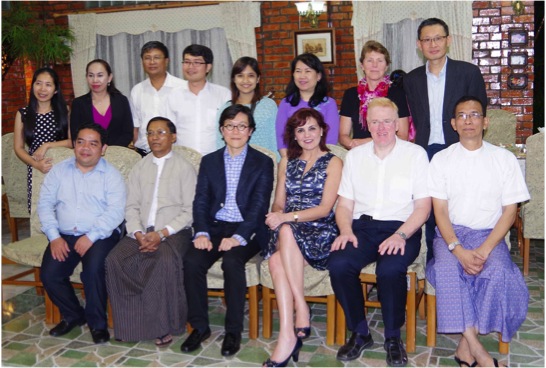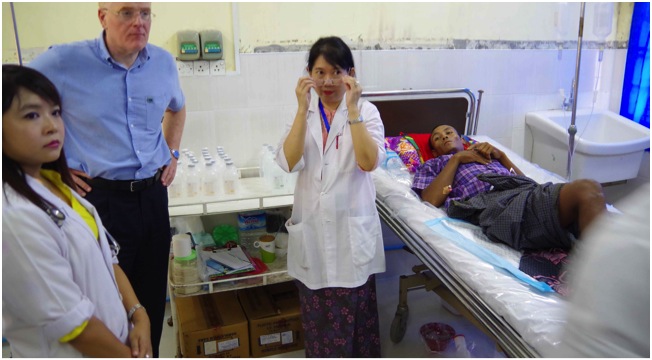 Because of previous political restrictions, this was the first ISN visit to Myanmar since the late 1990s when a number of visits were made involving senior ISN leaders (including Clarkson, Dirks, Schrier, Atkins and Kerr). During the restrictions, healthcare spending was severely restricted (1.5% of GDP). There has now been significant change with the arrival of the new government. Healthcare expenditure is growing and it is expected to reach 5% of GDP in the next two to three years.
Because of previous political restrictions, this was the first ISN visit to Myanmar since the late 1990s when a number of visits were made involving senior ISN leaders (including Clarkson, Dirks, Schrier, Atkins and Kerr). During the restrictions, healthcare spending was severely restricted (1.5% of GDP). There has now been significant change with the arrival of the new government. Healthcare expenditure is growing and it is expected to reach 5% of GDP in the next two to three years.
Myanmar remains a predominantly rural low-income country. Yangon (formerly Rangoon) is by far the largest conurbation, with about 5 million population. Myanmar has 18 nephrologists for 55 million population. There is a well-developed healthcare structure with rural health centres staffed by midwives, but offering some other resources including oral rehydration solution and snake antivenom. These refer to township hospitals and in turn to the major city hospitals.
 An ISN-endorsed Continuing Medical Education (CME) course was held in Yangon on August 9, 2014 focusing on glomerulonephritis. It was attended by some 200 physicians, mostly internists and general practitioners, and some pathologists. It was preceded on August 8, 2014 by a half day workshop on glomerular pathology attended by some 70 pathologists and physicians. Speakers at the CME were Chen Au Peh, John Feehally, TM Chan (Hong Kong) and Sophie Otto (renal pathologist, Adelaide), who also conducted the renal pathology workshop. On August 7 and 8, 2014, visits were also made to the renal units at Yangon General Hospital, Thingangyun Sanpya Hospital and Yangon Childrens’ Hospital. The quality of clinical discussion was high, challenging cases were presented. The focus was on lupus nephritis and AKI due to snake bites.
An ISN-endorsed Continuing Medical Education (CME) course was held in Yangon on August 9, 2014 focusing on glomerulonephritis. It was attended by some 200 physicians, mostly internists and general practitioners, and some pathologists. It was preceded on August 8, 2014 by a half day workshop on glomerular pathology attended by some 70 pathologists and physicians. Speakers at the CME were Chen Au Peh, John Feehally, TM Chan (Hong Kong) and Sophie Otto (renal pathologist, Adelaide), who also conducted the renal pathology workshop. On August 7 and 8, 2014, visits were also made to the renal units at Yangon General Hospital, Thingangyun Sanpya Hospital and Yangon Childrens’ Hospital. The quality of clinical discussion was high, challenging cases were presented. The focus was on lupus nephritis and AKI due to snake bites.
Current state of nephrology
Throughout the time of the restrictions, strong and sustained support for nephrology in Myanmar has been given by the Renal Unit at the Royal Adelaide Hospital, led initially by Randall Faull, and now by Chen Au Peh. They have developed a successful Sister Center between Royal Adelaide and the renal unit Yangon General Hospital. Their Sister Center has not of course borne the ISN logo nor received any ISN funding because of the restrictions. Despite the political restrictions nephrology has continued to develop slowly in Myanmar. Maintenance hemodialysis (HD) on a patient payment basis is available at Yangon General Hospital and Thingangyun Sanpya Hospital. There is no maintenance peritoneal dialysis (PD). There are plans to reactivate a living related donor transplant program.
AKI is managed with acute PD (stiff PD catheters and locally sourced fluids) at the two hospitals. Acute HD is used at the Defense Services Hospital. Snake bites account for 50% of all cases of AKI that reach the renal units. All IV fluids in Myanmar are prepared in a single government-funded facility. Acute PD uses one liter exchanges (the maximum tolerated volume by the physically small Burmese people) combining 500ml Ringers lactate and 500ml dextrose saline. The fluid in plastic bottles is very low cost (around 0.3 USD per bottle).
A large number of glomerular disease cases are seen, particularly lupus nephritis. Renal biopsy is practiced. Good quality light microscopy is available, but no immunofluorescence, or electron microscopy. Immunohistochemistry, as an alternative to immunofluorescence, is unreliable.
Pediatric nephrology has been developed at Yangon General Hospital. There is chronic HD (patient payer basis), and plans for a living related donor transplant program. Acute PD is offered for AKI. Renal biopsy is practiced. The progress in pediatric nephrology is particularly due to the sustained commitment of Professor HK Yip and her colleagues in Singapore who have trained a succession of pediatricians now working at the Yangon General Hospital and other pediatric centers in Myanmar.
Opportunities
 The Adelaide and Yangon General Hospital pair will make an application for ISN Sister Center status (their application will request no funding from ISN, they will continue to develop the sister center with Adelaide funds). There is a plan to establish immunofluorescence. Cryostat, immunofluorescence microscope, reagents have apparently already been ordered. Adelaide will support the necessary technician and pathologist training. Dr Peh is working on a number of strategies to improve the management of snake bites, including using Australian expertise to lyophilize the antivenom to improve shelf life in rural health centers. I have encouraged Myanmar colleagues to apply for ISN Fellowships and Educational Ambassadors.
The Adelaide and Yangon General Hospital pair will make an application for ISN Sister Center status (their application will request no funding from ISN, they will continue to develop the sister center with Adelaide funds). There is a plan to establish immunofluorescence. Cryostat, immunofluorescence microscope, reagents have apparently already been ordered. Adelaide will support the necessary technician and pathologist training. Dr Peh is working on a number of strategies to improve the management of snake bites, including using Australian expertise to lyophilize the antivenom to improve shelf life in rural health centers. I have encouraged Myanmar colleagues to apply for ISN Fellowships and Educational Ambassadors.
Consideration should be given to another CME course in Myanmar in 2015, and AKI and living donor transplant would be additional very relevant topics to cover. Lack of affordable and accessible pathology testing to confirm AKI may underestimate the AKI case load. Improvements in care, for example improved public education about snakebite, greater availability of antivenom, and more affordable and available pathology diagnostics may significantly increase the case load at township hospitals.
For more information about the ISN Programs, CLICK HERE.
